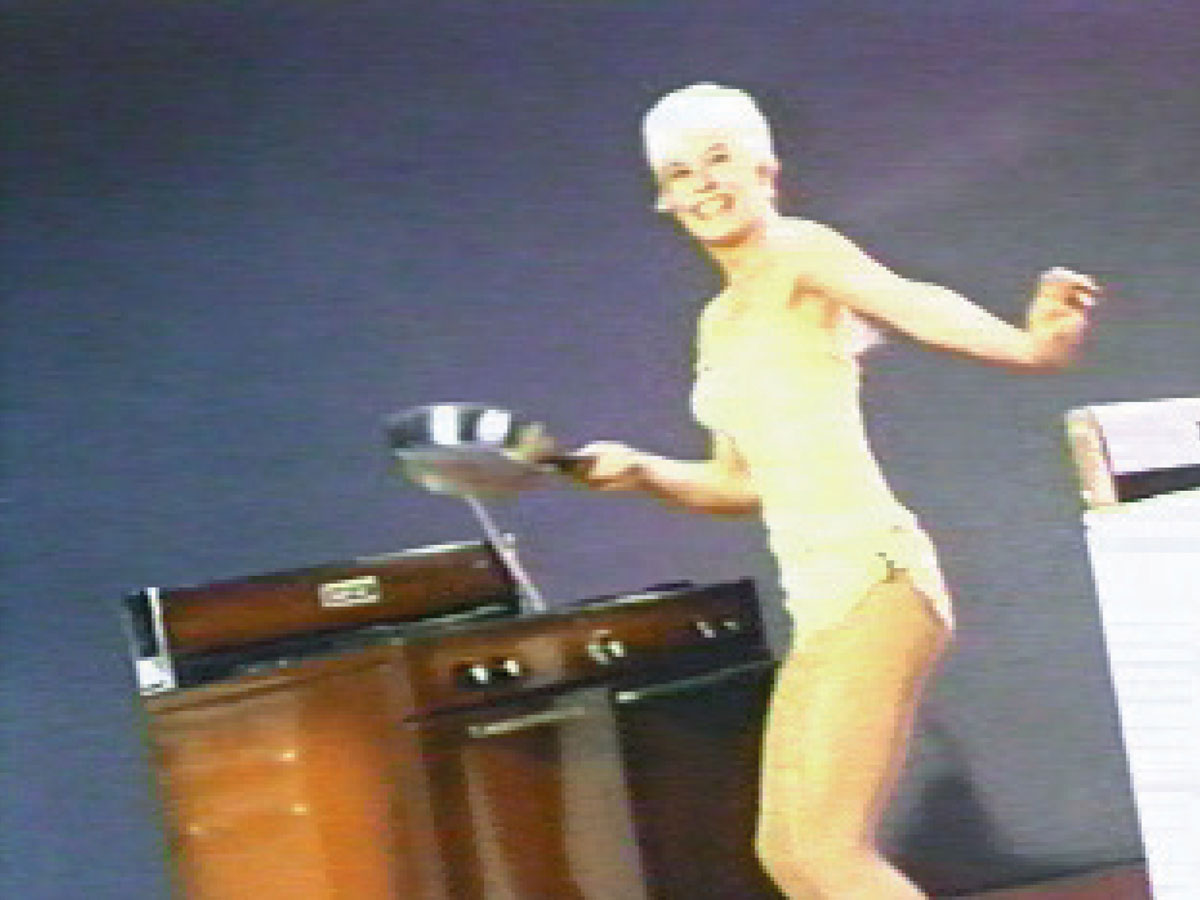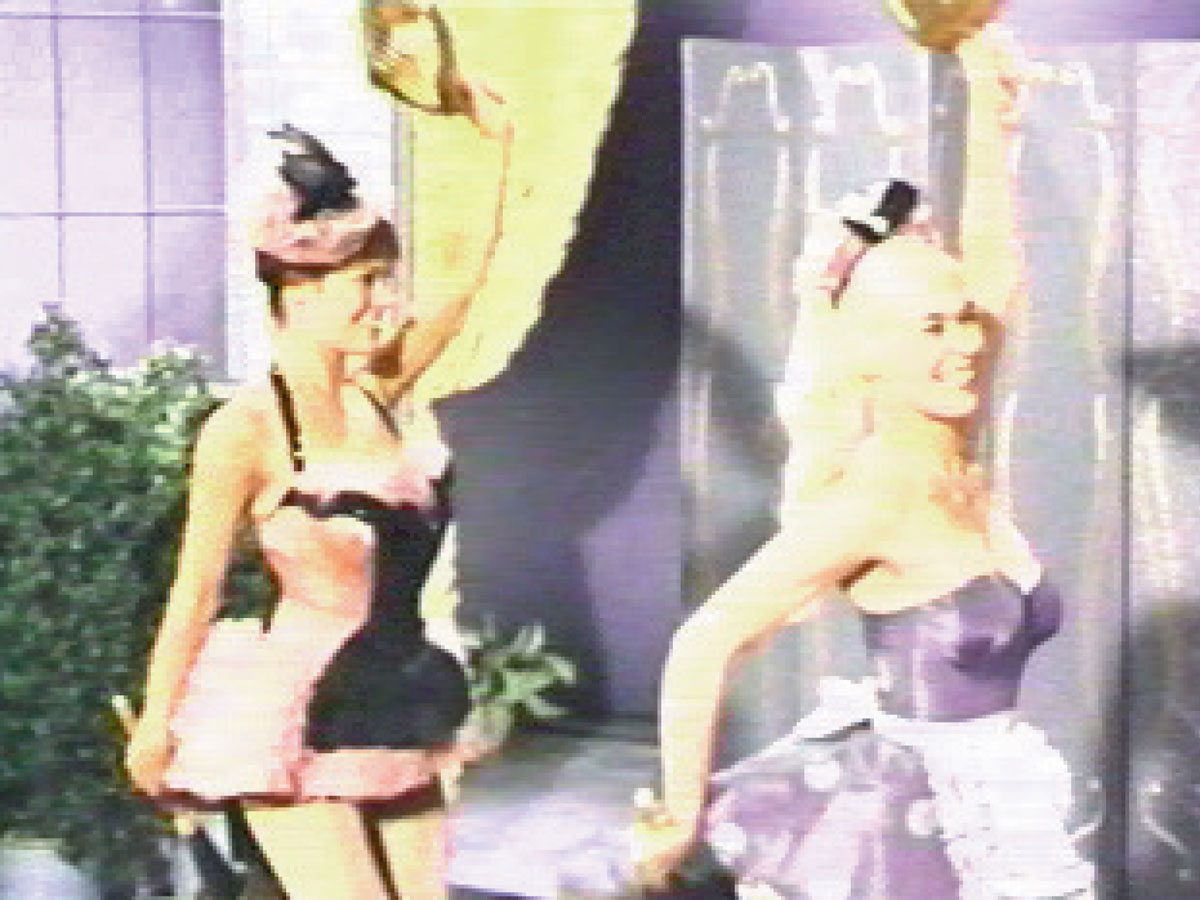The Clean Room / Love Machines
Unwinding the technology of the Scopitone
David Serlin
“The Clean Room” is a column by David Serlin on science and technology.
Last summer, I spent a warm evening at a rooftop party in Park Slope, Brooklyn, drinking beer and watching Scopitones, three-minute promotional films from the early 1960s, today regarded as precursors to the modern music video. On the tar-covered roof of a former boarding house, an audience of appreciative twenty-somethings and nostalgic baby boomers gathered to watch a single reel of perhaps 25 collected Scopitones, which were shown on the white sidewall of a rowhouse through an ancient, metallic blue, school board-issue 16-millimeter projector. Gulping down what seemed like gallons of black celluloid stock, the projector hummed with a reassuring clarity while broadcasting these stylized, deeply saturated Technicolor films representing a lost Atlantis of postwar youth culture, one full generation before the birth of MTV.
In recent years, Scopitones have acquired a certain cult status, providing inspiration for film festivals in the US, Europe, and Japan as well as the corporate corridors of Madison Avenue. One could easily spot, for example, the influence of Scopitones’ endless configurations of dance party choreography on 1998’s crop of advertisements for Gap khakis by graphic artist and video director Mike Mills. A smorgasbord of moody ballads, long-lost dance crazes, and less-than-one-hit wonders, the Scopitone parade includes everything from French pop diva Françoise Hardy’s “Tous Les Garçons et Les Filles,” filmed between Ferris wheel cars and girls’ petticoats at a Parisian street carnival, to George Mc-Kelvey’s “My Teenage Fallout Queen,” an unfunny folk protest parody dedicated to suburban radiation nightmares; to Joi Lansing’s “The Web of Love,” a camp spectacular involving witch doctors, human-sized spider webs, and a surfeit of impossibly large breasts.
Scopitones are a cinema buff’s wet celluloid dream. According to the Society for the Restoration and Preservation of Scopitone Jukeboxes and Films in Daly City, California, French and US record companies produced more than 700 Scopitones between 1960 and 1967. Collectors and unsuspecting junk dealers regularly uncover lost or rare examples of the genre from industrial warehouses and suburban garages alike. In addition, the high camp, soft-porn dimensions of Scopitones—referenced even by Susan Sontag in her seminal 1964 essay “Notes on Camp”—have made them mandatory viewing amongst connoisseurs of early 1960s mass-market kitsch and mavens of that era’s amateur erotica, porn, and sexploitation films. Yet for all the æsthetic pleasure that Scopitone images ultimately provide, watching them as 16-millimeter projections or as VHS videos gives them a partially elevated cinematic shape, one that is, in fact, quite removed from the films’ more popular and low-brow origins.
The term “Scopitone” itself refers not to the films but to the machines on which the films were first introduced to the viewing public. Scopitone players, bulky forerunners of the video jukebox, were mechanical, coin-operated vending machines outfitted with 30" viewing screens and internal mechanisms that delivered a selection of short 16-millimeter films on demand. To a certain degree, then, the critical fixation on Scopitones’ cinematic qualities obscures the more complex technological legacy that lurks beneath the groovy music and white go-go boots.
In the late 1940s a cadre of French film enthusiasts gained access to a huge surplus of 16-millimeter film cameras used for high-altitude reconnaissance missions. While they had already developed a way to convert these surplus cameras into film projectors, it was not until the late 1950s that they configured the projector housings to accommodate a programmable, rotating carousel that could hold a vertical stack of up to 36 short films. By 1960, the group had perfected their product and sold their design through a newly-organized company, CAMCA—an acronym for the baroque-sounding Compagnie d’Applications Mecaniques a L’Electronique au Cinema et a l’Atomistique. They named their inventions “Scopitones.” In 1964, CAMCA sold North American distribution rights to a Chicago-based billboard company, Tel-A-Sign, which specialized in building customized neon signage for restaurants and bowling alleys. The success of vending machine technology in the United States combined with the popularity of consumer video electronics was enough to convince distributors of coin-operated machines to add Scopitones to their sales list. The large-format plastic cabinets and view screens, a sure sell, seemed positively visionary, the enviable products of a space-age culture lulled into soporific succor by the push-button ease of passive entertainment.
The meteoric rise and spectacular fall of Tel-A-Sign—a company that made and lost millions in less than a decade—and film production companies such as Debbie Reynolds’s Harmanee, the source of most great domestic Scopitones, has been charted in a 1999 essay by film historian Jack Stevenson. In “The Jukebox that Ate the Cocktail Lounge: The Story of Scopitone,”[1] Stevenson tells the Scopitone story as a uniquely American, fallen corporate fantasia involving Miami Beach lawyers, Senate investigations into mob activity, and the indignant wrath of the fundamentalist Christian right. By 1965, Tel-A-Sign’s most triumphant year, thousands of Scopitone machines installed throughout the United States showed off scores of new promotional films that were made by industry-owned production companies and shipped out like cases of Harvey’s Bristol Cream by vast networks of film distributors. By 1969, however, pending lawsuits against and bankruptcy applications by Tel-A-Sign had destroyed the domestic Scopitone empire. The machines became forgotten relics of niche-marketed consumer technology, even though the production of music films by record companies did not abate until the early 1970s. The Beatles’ promotional video for “Hello Goodbye,” to name but one example, was filmed on 10 November 1967, the same day that I was born.


Although the Scopitone’s mystique as an icon of popular entertainment was fading by the end of the 1960s, within a few years a large proportion of the original CAMCA projection mechanisms inside Scopitone players were reassembled for alternative ideological uses. In the United States, for example, the same machines formerly used to show Scopitone films featuring button-down American balladeers and bosomy French chanteuses were installed at NASA’s visitor centers at Houston and Cape Canaveral. The former video jukeboxes were outfitted with films of rocket launches and animated cartoons of future space colonies that promoted the wonders of—and sustained federal funding for—ærospace technology and research. The Scopitone came to dish out the visual propaganda with which NASA countered public indifference for the US space program in the 1970s. In France, the same Scopitone players into which French workers and teenagers had fed beaucoup de centimes were installed deep in rural coal mines, where they were supplied with reels of procedural and safety films. The same machines that happily objectified sexy pop moppets like Sylvie Vartan and Elvis look-a-like crooners (like Johnny Halliday, Vartan’s real-life husband) now helped shape French coal miners. The confusion was further compounded when films were screened for these same subjects in settings far removed from the familiar comfort of neighborhood cafés. For a generation of workers and vacationers of different classes located on opposite sides of the Atlantic, staring into the heart of the dark Scopitone to watch anything other than light entertainment must have produced stunning cognitive dissonance not unlike, one imagines, the experience of watching films made for Scopitone machines in the early 1960s while sitting on the rooftop of a Brooklyn rowhouse some forty years later.
Fortunately, the Scopitone player’s military-industrial heritage does not seem to have tarnished the humble, low-tech æsthetic that their promotional films preserve for contemporary viewers. The remaining films remind us that we are a generation trapped, for better or worse, in a media-literate and technology-savvy era in which many house-holds regularly use digital video cameras, DVD players, and streaming QuickTime and RealPlayer cybercasts with a good deal of expertise. It is not difficult, as Stevenson points out, to draw parallels between the amateur cinematography of Scopitone films and the work of 1960s Pop auteurs like Andy Warhol, Russ Meyer, or brothers Mike and George Kuchar. At the same time, one is constantly reminded that Scopitones were intended from the beginning as an unapologetically commercial venture. Scopitone machines were planned originally for family-friendly venues like pizza parlors and bus terminals, even if they also surfaced in more swinging commercial spaces like after-hours nightclubs and bowling alley cocktail lounges. They were nothing more or less than hulking, glittering vending machines that offered products not unlike those of other similar coin-operated machines that jet-set pleasure seekers wearing Oleg Cassini capes or Pierre Cardin pantsuits might have encountered in a hotel bar in Montreux, a seedy nightclub in Atlantic City, or in a porn theater in the rue St. Denis or (pre-Disney) Times Square.
In this sense, the technology of the Scopitone, even more than the films that it played, is the missing link in a visual genealogy of popular æsthetic forms of the latter half of the twentieth century.
- See http://hjem.get2net.dk /jack_stevenson/scopi.htm [link defunct—Eds.].
David Serlin is a contributing editor to Cabinet. His forthcoming books include Artificial Parts and Practical Lives: Histories of Modern Prosthetics and Replaceable You: Engineering the American Body after World War II.
Spotted an error? Email us at corrections at cabinetmagazine dot org.
If you’ve enjoyed the free articles that we offer on our site, please consider subscribing to our nonprofit magazine. You get twelve online issues and unlimited access to all our archives.